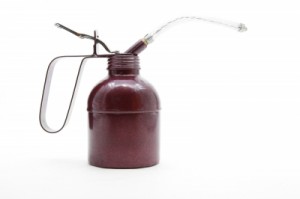Home > Press > Lubricating with Nanometer-Sized Silver
 |
| Image: Workshop and DIY / FreeDigitalPhotos.net |
Abstract:
The ever-increasing demands for energy efficiency and high temperature operation of machines require a careful consideration of lubricants for optimal performance. Tribological components like bearings and gears have driven the continual sophistication of lubricating materials and the development of additives which enhance their performance.
Lubricating with Nanometer-Sized Silver
Germany | Posted on March 22nd, 2012These additives are designed to enhance specific attributes of lubricant properties, such as viscosity, performance at particular temperatures, friction and wear reduction, rust and corrosion prevention, or oxidative stability. Conventional oils and greases undergo severe degradation at elevated temperatures, whereas solid lubricants can function at far higher temperatures.
Commonly, graphite and MoS2, which have been studied for decades, are used as lubricant additives, but nanometer-sized particles have more recently made an appearance. Nanoparticles are particularly effective because they form more stable dispersions in oils than do larger particles.
To get an efficient and cost-effective system, Christina P. Twist and co-workers from the Northwestern University in Evanston, Illinois (USA), and the University of Jordan in Amman (Jordan) synthesized two silver complexes and added them to engine oil at various concentrations. Silver is a relatively soft metal and has been previously investigated as a solid lubricant in the form of coatings.
The researchers report on the thermolytic and tribological properties of these complexes as they are transformed to lubricious silver metal. They evaluated the performance of these complexes as lubricant additives via pin-on-disk friction tests and wear scar measurements.
Results of the friction tests and wear measurements indicate a significant reduction in wear and little change in friction. The improved wear performance is attributed to the thermolysis and deposition of the silver-based complexes in the wear scar. However, while the oil and silver complex suspensions were mixed thoroughly before testing for at least 15 min to achieve as homogeneous distribution as possible, some larger crystallites were likely present. This problem can be remedied in future using more lipophilic ligands.
####
For more information, please click here
Copyright © Wiley-VCH Materials Science Journals
If you have a comment, please Contact us.Issuers of news releases, not 7th Wave, Inc. or Nanotechnology Now, are solely responsible for the accuracy of the content.
| Related News Press |
News and information
![]() Simulating magnetization in a Heisenberg quantum spin chain April 5th, 2024
Simulating magnetization in a Heisenberg quantum spin chain April 5th, 2024
![]() NRL charters Navy’s quantum inertial navigation path to reduce drift April 5th, 2024
NRL charters Navy’s quantum inertial navigation path to reduce drift April 5th, 2024
![]() Discovery points path to flash-like memory for storing qubits: Rice find could hasten development of nonvolatile quantum memory April 5th, 2024
Discovery points path to flash-like memory for storing qubits: Rice find could hasten development of nonvolatile quantum memory April 5th, 2024
Discoveries
![]() Chemical reactions can scramble quantum information as well as black holes April 5th, 2024
Chemical reactions can scramble quantum information as well as black holes April 5th, 2024
![]() New micromaterial releases nanoparticles that selectively destroy cancer cells April 5th, 2024
New micromaterial releases nanoparticles that selectively destroy cancer cells April 5th, 2024
![]() Utilizing palladium for addressing contact issues of buried oxide thin film transistors April 5th, 2024
Utilizing palladium for addressing contact issues of buried oxide thin film transistors April 5th, 2024
Materials/Metamaterials/Magnetoresistance
![]() Nanoscale CL thermometry with lanthanide-doped heavy-metal oxide in TEM March 8th, 2024
Nanoscale CL thermometry with lanthanide-doped heavy-metal oxide in TEM March 8th, 2024
![]() Focused ion beam technology: A single tool for a wide range of applications January 12th, 2024
Focused ion beam technology: A single tool for a wide range of applications January 12th, 2024
Announcements
![]() NRL charters Navy’s quantum inertial navigation path to reduce drift April 5th, 2024
NRL charters Navy’s quantum inertial navigation path to reduce drift April 5th, 2024
![]() Discovery points path to flash-like memory for storing qubits: Rice find could hasten development of nonvolatile quantum memory April 5th, 2024
Discovery points path to flash-like memory for storing qubits: Rice find could hasten development of nonvolatile quantum memory April 5th, 2024
Industrial
![]() Boron nitride nanotube fibers get real: Rice lab creates first heat-tolerant, stable fibers from wet-spinning process June 24th, 2022
Boron nitride nanotube fibers get real: Rice lab creates first heat-tolerant, stable fibers from wet-spinning process June 24th, 2022
![]() Nanotubes: a promising solution for advanced rubber cables with 60% less conductive filler June 1st, 2022
Nanotubes: a promising solution for advanced rubber cables with 60% less conductive filler June 1st, 2022
![]() Protective equipment with graphene nanotubes meets the strictest ESD safety standards March 25th, 2022
Protective equipment with graphene nanotubes meets the strictest ESD safety standards March 25th, 2022
![]() OCSiAl receives the green light for Luxembourg graphene nanotube facility project to power the next generation of electric vehicles in Europe March 4th, 2022
OCSiAl receives the green light for Luxembourg graphene nanotube facility project to power the next generation of electric vehicles in Europe March 4th, 2022
|
|
||
|
|
||
| The latest news from around the world, FREE | ||
|
|
||
|
|
||
| Premium Products | ||
|
|
||
|
Only the news you want to read!
Learn More |
||
|
|
||
|
Full-service, expert consulting
Learn More |
||
|
|
||








